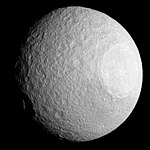Penelope (crater)
 Penelope crater (center) | |
| Feature type | Peak-ring impact crater |
|---|---|
| Location | Tethys |
| Coordinates | 10°50′S 110°47′E / 10.83°S 110.78°E[1] |
| Diameter | 207.5 km |
| Eponym | Penelope |
Penelope is the fourth-largest impact crater on Saturn's moon Tethys. It is 208 kilometers wide, and is located near the equator in the center of trailing hemisphere of the moon at 10.8°S, 249.2°W.[1] It is approximately opposite to the largest crater on Tethys—Odysseus. Penelope is named after Penelope of Greek mythology, wife of the legendary king Odysseus from the Odyssey epic. The name was officially approved by the International Astronomical Union (IAU) in 1983.[1]
Geology and structure[edit]
Penelope is a highly elliptical crater, wih its shortest axis being roughly 180 kilometers and its longest axis being roughly 220 kilometers. Penelope's longest axis is aligned almost exactly north-south, deviating by only 1°.[2]: 3 Nevertheless, with an average diameter of roughly 207.5 kilometers,[1] it is the fourth-largest known impact structure on Tethys.[3] Its western crater wall is bright, with fresh ice from Tethys's crust exposed; the eastern crater wall is comparatively much more degraded. Within Penelope's basin floor is a heavily degraded central peak ring approximately 50 kilometers in diameter. The central peak ring's northern and southeastern arcs are the best-preserved sections of this feature. Several faults cross Penelope, including a tectonic feature that crosses the basin floor yet does not continue beyond the crater rim.[4]: 10 Penelope is rather deep and unrelaxed, having not been flattened out as with some of Tethys's other major impact craters. It and another nearby unrelaxed impact basin, Antinous, may be a part of a province of unrelaxed craters between ~120° E and ~30° E.[5]: 49
The region Penelope is located in is dominated by heavily cratered terrain. To the east of Penelope is a network of roughly parallel narrow troughs that cut across a system of older, more degraded troughs. Regions to the east are especially densely cratered and rugged. Unusually, Penelope, alongside most of Tethys's other large impact craters, are all concentrated on Tethys's trailing hemisphere to the south of the equator.[4]: 7
References[edit]
- ^ a b c d "Penelope". Gazetteer of Planetary Nomenclature. USGS Astrogeology Research Program. (Center Latitude: -10.83°, Center Longitude: 249.22°; Planetographic, +West)
- ^ Ferguson, Sierra N.; Rhoden, Alyssa R.; Kirchoff, Michelle R.; Salmon, Julien J. (10 June 2022). "A unique Saturnian impactor population from elliptical craters". Earth and Planetary Science Letters. 593: 117652. Bibcode:2022E&PSL.59317652F. doi:10.1016/j.epsl.2022.117652.
- ^ Stephen, Katrin; Wagner, Roland; Jaumann, Ralf; et al. (April 2015). Tethys - Geological and Spectral Properties (PDF). EGU General Assembly 2015. Vienna, Austria. Bibcode:2015EGUGA..17.7306S. 7306.
- ^ a b Stephen, Katrin; Wagner, Roland; Jaumann, Ralf; et al. (August 2016). "Cassini's geological and compositional view of Tethys" (PDF). Icarus. 274: 1–22. Bibcode:2016Icar..274....1S. doi:10.1016/j.icarus.2016.03.002.
- ^ White, Oliver L.; Schenk, Paul M.; Bellagamab, Anthony W.; Grimm, Ashley M.; Dombard, Andrew J.; Bray, Veronica J. (May 2017). "Impact crater relaxation on Dione and Tethys and relation to past heat flow". Icarus. 288: 37–52. Bibcode:2017Icar..288...37W. doi:10.1016/j.icarus.2017.01.025.

